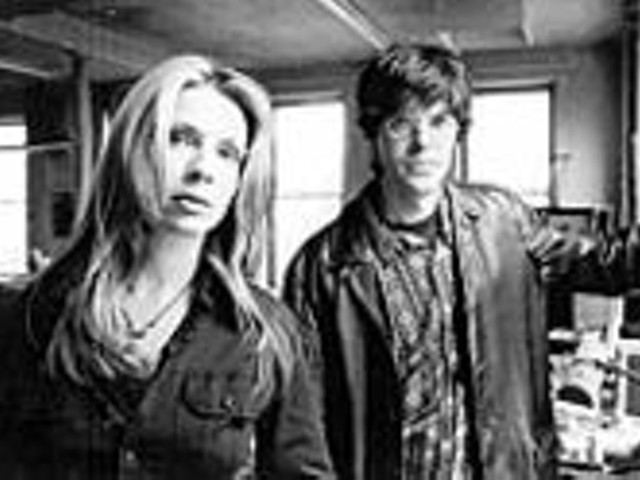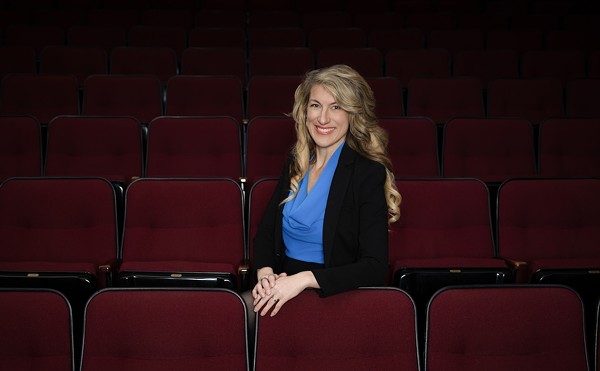So the Contemporary Art Museum's completion and opening must be considered in this larger context, in relation to the contributions these other buildings have made to the city. How does it stack up? Extremely well. So well, in fact, that the building exudes the air of having always been there. It is confident, but not at all condescending, playing well with its neighbors in an unassuming, natural way. It's an impressive achievement, really, especially when one considers that it was completed for $8 million (a paltry sum by contemporary architectural standards for such projects), by an architect who was until recently unknown to most St. Louisans (Portland, Oregon's Brad Cloepfil), on a site to be shared with a fairly daunting architectural presence (Tadao Ando's Pulitzer Foundation for the Arts). But there the two buildings stand, striking an easy balance and maintaining an intelligent dialogue on the virtues of concrete and the modernist architectural idiom.
For all their similarities, the Pulitzer and the Contemporary manage to generate striking contrasts. Along Washington Boulevard, the Pulitzer appears tranquil, composed and enclosed, all cool verticals and horizontals with just the hint of narrow open window space above, on the second level. The Contemporary picks up where the Pulitzer leaves off, presenting a darker gray face of steel mesh and concrete that gently introduces a glass window motif carried boldly around the corner in a sweeping curve, as if to embrace the entire cityscape at its back door.
Inside the Pulitzer, the sense of intimacy is maintained by the human scale of the gallery spaces and the gentle control of sight lines and viewer movement. Entering the Contemporary, on the other hand, one is presented with an enormous yawn of space, which feels like the architectural equivalent of the extreme-sport concept of "big air" -- freedom, versatility and joy in movement. There are any number of choices about how to explore once inside the Contemporary: You can head to the left, up the open concrete stairway to the balcony galleries with their unimpeded views into the main chasm of the museum. Or you can walk down the central stairs and wander between and around the exhibit walls. Likewise, you can head toward the bank of windows that lure visitors toward the open courtyard shared with the Pulitzer and featuring Richard Serra's spectacular spiral sculpture, Joe.
All in all, the Contemporary is a great architectural success, a bold yet understated addition to St. Louis' burgeoning cultural landscape. And it's precisely the kind of space the institution needs to realize its mission of engaging the public with art by new and emerging artists. The same can be said about the Contemporary's inaugural exhibition, A Fiction of Authenticity: Contemporary Africa Abroad, curated by Shannon Fitzgerald (of the Contemporary) and Tumelo Mosaka (of the Brooklyn Museum of Art). The exhibition brings together eleven African and African-diaspora artists whose works invite viewers to reflect on notions of identity, authenticity, home and displacement, in sometimes humorous, often devastating ways.
Godfried Donkor's Kumasi de Ville (2003) presents viewers with a wall of family and other group photographs, showing people in indeterminate settings. The photographs invite the viewer to build a larger narrative or family history; but Donkor's photographic history is a fiction, built from images of his upbringing in Ghana and archival portraits of people he has never met in St. Louis.
Like all the other artists featured in A Fiction of Authenticity, Donkor's life has been characterized by movement around the world, to the point that his identity cannot be fixed by nationality or borders. He is an African in London, where he has chosen to live; but he is considered European when he returns to Africa. An optimist would call Donkor a citizen of the world; a pessimist would consider him alien, in any country.
Alienation, fear and the compromise of identity are at the heart of video installations by Zineb Sedira and Ingrid Mwangi. And in a complex, multisectional installation, SUISSE DU SUD, Expo 03, Fatma Charfi reflects on Swiss national identity and her experience as a Tunisian-born resident of Switzerland.
None of the artists in A Fiction of Authenticity is local, but a few of them nonetheless chose to reflect on identity and authenticity as it plays out close to home, in St. Louis. In a strikingly simple yet effective installation, Siemon Allen features back issues of the St. Louis Post-Dispatch, zeroing in on any mention of South Africa. Allen deftly demonstrates the media's power in shaping our conceptions of other peoples and nations. Meschac Gaba conducted a faux archeological dig of mundane contemporary objects buried on the museum's grounds. Viewers can witness the discovery of these "artifacts" through Ground Penetrating Radar images or observe them firsthand on display tables.
For the most part, the works in the exhibition refrain from naming specific political regimes, nations or colonizers. The artists tend instead to employ broad metaphors to tell stories of colonial and postcolonial history, experience and identity. (A notable exception is Sedira's Mother, Father and I, a powerful video piece featuring her parents' explicit reflections on their lives in French-occupied Algeria.)
The storytelling approach is apt here because stories inevitably bring with them questions as to their own veracity: Is the story true? Is the experience "authentic"? And why does our culture invest so much value in authenticity itself? In keeping with the exhibition's title, these works trade in fictions rather than supposed "truths." Indeed, this art seems to destabilize truth as a category and propose the liberating power of storytelling and of fiction.
In a delicious irony, A Fiction of Authenticity: Contemporary Africa Abroad has opened during the run of The Lion King, just around the corner at the Fox. It's tempting to imagine that the curators engineered this coincidence with a wink at the musical, one of the most lucrative fictions of African authenticity ever produced. Maybe they did, maybe they didn't. Either way, it makes a good story.





